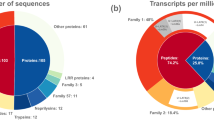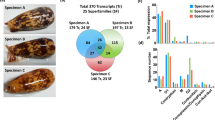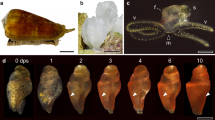Abstract
Numerous non-mammalian vertebrates have evolved lethal venoms to aid either in securing prey or as protection from predators, but modern mammals that use venoms in these ways are rare, including only the duck-billed platypus (Ornithorhynchus), the Caribbean Solenodon, and a few shrews (Soricidae) (Order Insectivora)1. Here we report evidence of a venom delivery apparatus in extinct mammals, documented by well-preserved specimens recovered from late Palaeocene rocks in Alberta, Canada2,3. Although classified within Eutheria, these mammals are phylogenetically remote from modern Insectivora4 and have evolved specialized teeth as salivary venom delivery systems (VDSs) that differ markedly from one another and from those of Solenodon and shrews. Our discoveries therefore show that mammals have been much more flexible in the evolution of VDSs than previously believed, contradicting currently held notions that modern insectivorans are representative of the supposedly limited role of salivary venoms in mammalian history. Evidently, small predatory eutherians have paralleled colubroid snakes5 in evolving salivary venoms and their delivery systems several times independently.
This is a preview of subscription content, access via your institution
Access options
Subscribe to this journal
Receive 51 print issues and online access
$199.00 per year
only $3.90 per issue
Buy this article
- Purchase on Springer Link
- Instant access to full article PDF
Prices may be subject to local taxes which are calculated during checkout


Similar content being viewed by others
References
Dufton, M. J. Venomous mammals. Pharmac. Ther. 53, 199–215 (1992)
Fox, R. C. in Dawn of the Age of Mammals in the Northern Part of the Rocky Mountain Interior (eds Bown, T. M. & Rose, K. D.) 51–70 (Geological Society of America, Boulder, Colorado, 1990)
Scott, C. S. Taxonomically diverse late Paleocene mammal localities from south central Alberta, Canada. J. Vertebr. Paleont. Abstr. 24, 111A (2004)
McKenna, M. C. & Bell, S. K. Classification of Mammals Above the Species Level (Columbia Univ. Press, New York, 1997)
Jackson, K. The evolution of venom-delivery systems in snakes. Zool. J. Linn. Soc. 137, 337–354 (2003)
Gazin, C. L. Paleocene mammalian faunas of the Bison Basin in south-central Wyoming. Smithson. Misc. Coll. 131, 1–57 (1956)
Lofgren, D. L., et al. in Late Cretaceous and Cenozoic Mammals of North America (ed. Woodburne, M. O.) 43–105 (Columbia Univ. Press, New York, 2004)
Gingerich, P. D. New Adapisoricidae, Pentacodontidae, and Hyopsodontidae (Mammalia, Insectivora and Condylarthra) from the late Paleocene of Wyoming and Colorado. Contrib. Mus. Paleont. Univ. Mich. 26, 227–255 (1983)
Bellairs, A. d'A. Reptiles: Life History, Evolution, and Structure (Harper, New York, 1957)
Lake, A. R. & Trevor-Jones, T. R. The venom apparatus of the boomslang or tree snake, Dispholidus typus. S. Afr. J. Sci. 92, 167–169 (1996)
Kita, M. et al. Blarina toxin, a mammalian lethal venom from the short-tailed shrew, Blarina brevicauda: isolation and characterization. Proc. Natl Acad. Sci. USA 101, 7542–7547 (2004)
Rabb, G. B. Toxic salivary glands in the primitive insectivore Solenodon. Nat. Hist. Miscellanea 190, 1–3 (1959)
Macdonald, D. (ed.) The Encyclopedia of Mammals (Facts On File, New York, 1984)
McDowell, S. B. Jr The Greater Antillean insectivores. Bull. Am. Mus. Nat. Hist. 115, 113–214 (1958)
Goin, C. J. & Goin, O. B. Introduction to Herpetology (W. H. Freeman, San Francisco, 1972)
Acknowledgements
We thank Y. Sun for fossil preparation, D. Spivak for technical assistance, M. Caldwell for use of photographic equipment, and K. Gao, K. Soehn, G. Stonley, M. Webb and G. Youzwyshyn for field assistance. This work was supported by the Natural Sciences and Engineering Research Council of Canada and the University of Alberta.
Author information
Authors and Affiliations
Corresponding author
Ethics declarations
Competing interests
Reprints and permissions information is available at npg.nature.com/reprintsandpermissions. The authors declare no competing financial interests.
Rights and permissions
About this article
Cite this article
Fox, R., Scott, C. First evidence of a venom delivery apparatus in extinct mammals. Nature 435, 1091–1093 (2005). https://doi.org/10.1038/nature03646
Received:
Accepted:
Issue Date:
DOI: https://doi.org/10.1038/nature03646
This article is cited by
-
Shrew's venom quickly causes circulation disorder, analgesia and hypokinesia
Cellular and Molecular Life Sciences (2022)
-
A reassessment of the purported venom delivery system of the bird-like raptor Sinornithosaurus
Paläontologische Zeitschrift (2011)
-
First evidence of poisonous shrews with an envenomation apparatus
Naturwissenschaften (2007)
Comments
By submitting a comment you agree to abide by our Terms and Community Guidelines. If you find something abusive or that does not comply with our terms or guidelines please flag it as inappropriate.



